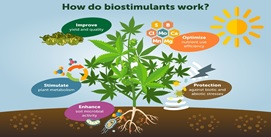22 September, 2025
Biostimulants
Mon 21 Jul, 2025
Context
In the backdrop of the recently launched Viksit Krishi Sankalp Abhiyan, the Union Agriculture Minister brought critical attention to the unregulated sale of biostimulants in India. Stressing the importance of scientific validation, the minister announced that only biostimulants proven beneficial through scientific means will receive regulatory approval. This move marks a significant step towards ensuring that farmers gain from safe and effective agricultural inputs.
What are Biostimulants?
- Biostimulants are substances or microorganisms that, when applied to plants, seeds, or soil, stimulate natural biological processes. Unlike fertilizers, which directly supply nutrients, biostimulants enhance plant growth by improving nutrient uptake, boosting tolerance to abiotic stress, and enhancing crop quality.
Key Functions of Biostimulants:
- Improve plant resistance to drought, salinity, and extreme temperatures
- Enhance nutrient absorption and efficiency
- Promote beneficial soil microbial activity
- Boost overall plant health, vigor, and yield
Types and Examples of Biostimulants
| Category | Description | Examples |
| Humic & Fulvic Acids | Derived from decayed plant, animal, or microbial matter | Peat, Leonardite, Soft Coal |
| Seaweed Extracts | Processed from seaweed using various extraction methods | Soluble Powders, Liquid Extracts |
| Liquid Manure Composting | Manure composted with microbial growth enhancers | Liquid Biofertilizer from Manure |
| Beneficial Microorganisms | Bacteria and fungi that aid root development and plant growth | Bacillus, Rhizobium Fungi |
These substances do not act as fertilizers or pesticides but help in enhancing the natural biological functions of plants.
Role in Sustainable Agriculture
Biostimulants are increasingly seen as vital components of sustainable agriculture due to the following reasons:
- Abiotic Stress Management:
They help crops survive harsh climatic conditions like drought, salinity, frost, and extreme heat.
- Efficient Nutrient Utilization:
By improving root health and nutrient uptake, biostimulants make both existing soil nutrients and added fertilizers more effective.
- Soil Health Enhancement:
They foster a healthy soil ecosystem by promoting beneficial microorganisms, critical for long-term soil fertility.
- Improved Crop Quality and Yield:
Healthier plants not only yield more but also produce better-quality harvests, benefiting both farmers and consumers.
Biostimulant Market Outlook in India
- The Indian biostimulant market, valued at approximately USD 355–362 million in 2024, is witnessing rapid growth. It is projected to reach between USD 1.13 billion and USD 1.2 billion by 2032, reflecting a shift towards organic and sustainable farming practices.
Regulatory Framework in India
In India, biostimulants are regulated under the Fertilizer (Control) Order (FCO), 1985, which was issued under the Essential Commodities Act, 1955. Recent amendments in 2024 and 2025 have tightened norms, emphasizing the need for:
- Scientific validation of product efficacy
- Mandatory registration with the Department of Agriculture Cooperation
- Compliance with safety and quality standards
This regulatory tightening aims to prevent the proliferation of ineffective or harmful biostimulant products in the market.
Related Government Initiatives on Organic & Sustainable Farming
| Scheme | Year of Launch | Objective |
| National Project on Organic Farming (NPOF) | 2004 | Promote organic farming inputs |
| Paramparagat Krishi Vikas Yojana (PKVY) | 2015 | Promote traditional organic farming practices |
| Mission Organic Value Chain Development for North Eastern Region (MOVCDNER) | 2015 | Develop organic value chains in NE states |
These initiatives, in tandem with the biostimulant regulatory reforms, aim to make Indian agriculture more sustainable and eco-friendly.


















